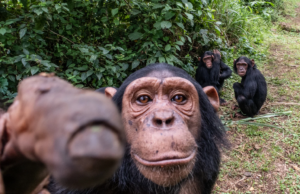The Gorillas Dian Fossey Saved Are Facing New Challenges

By
Shortly after dawn two mountain gorillas swing gracefully over the shoulder-high stone wall that borders Volcanoes National Park in northwestern Rwanda. Landing lightly on cropped grass, the silverbacks stroll downhill through cultivated fields—knuckle-walking at first, then upright on two legs. The adult males belly up to eucalyptus trees and score the bark with their incisors. Then, joined by females and juveniles from their group, which researchers call Titus, they advance on a spindly stand of bamboo.
Later that morning Veronica Vecellio, the gorilla program manager for the Dian Fossey Gorilla Fund International, settles onto a log inside the park, high on a thickly forested, mist-shrouded slope of the Virunga Mountains, and turns her attention to a silverback known as Urwibutso. A frequent wall hopper, Urwibutso is carefully folding thistle leaves before placing them in his mouth. When he turns toward Vecellio, an ebullient woman who studies gorilla group dynamics, she snaps a picture, then zooms in on a wound on his nose.
“He fought with another silverback from Titus this morning,” she whispers intently. (Silverbacks get their name from the white hairs that blanket males, saddlelike, when they reach maturity.)
The Titus group has been sneaking over the park wall for 10 years, Vecellio says, and each year it ventures farther. The situation isn’t ideal. Gorillas don’t eat the potatoes or beans that villagers plant—not yet. But they do kill trees, a valuable resource, and come into close contact with human and livestock waste, which is loaded with pathogens. The potential for disease spillover between species is high, and the chance gorillas could survive a virulent outbreak is low. So when the Titus group gets within a stone’s throw of the mud-and-stick homes of Bisate, a village of about 10,000 people, park guards waving bamboo poles slowly shoo them back uphill. Vecellio sighs. “This is the price we’re paying for success.”
Dian Fossey, an American with no experience researching wild animals, arrived in Africa to study mountain gorillas in the late 1960s at the urging of anthropologist Louis Leakey and with financing from the National Geographic Society. By 1973 the population of these great apes in the Virunga Mountains had fallen below 275, but today, thanks to extreme conservation measures—constant monitoring, intensive antipoaching efforts, and emergency veterinary interventions—there are now about 480.
More gorillas have been a boon for genetic diversity: For years, researchers have documented evidence of inbreeding, such as cleft palates and webbed fingers and toes. But the population uptick has a downside. “Group sizes are larger,” Vecellio says. The Pablo group hit 65 members in 2006; it’s now down to about 25—still almost three times as large as average gorilla groups in the Virunga Mountains in Uganda and the Democratic Republic of the Congo. “The density of groups in certain areas is also up,” Vecellio adds.
Clashes between groups, which raise the odds gorillas will suffer injuries or commit infanticide to wipe out a competing male’s genes, are six times as frequent now as 10 years ago. “We’re seeing an increase in the level of stress too,” Vecellio says, and possibly increased exposure to stress-related diseases.
Read here the full article with photos.

 Español
Español
 Português
Português








